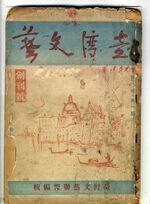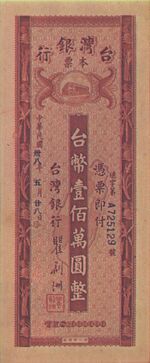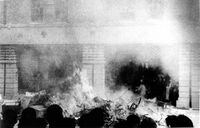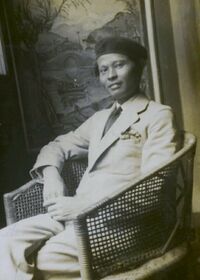حادثة 28 فبراير
| حادثة 28 فبراير February 28 incident | |||
|---|---|---|---|
 في 28 فبراير 1947، تجمعت الحشود أمام فرع تايپـِيْ لمكتب مونوپولي للاحتجاج، تم تكديس وحرق أعواد الثقاب والسجائر والأشياء الأخرى. | |||
| التاريخ | 27 فبراير – 16 مايو 1947 | ||
| المكان | |||
| السبب |
| ||
| الأهداف | الإصلاح السياسي، ضمن أهداف أخرى | ||
| الطرق | Demonstrations, political negotiations, weapons collection, takeovers, armed protests | ||
| أسفرت عن |
| ||
| أطراف الصراع الأهلي | |||
| |||
| الشخصيات الرئيسية | |||
| |||
| الخسائر | |||
| القتلى | بين 18,000 و 28,000 شخصاً[1][2] | ||
حادثة 28 فبراير، ويشار إليها أيضاً بأسماء مذبحة 28 فبراير،[3][4] حادثة 228،[5] أو مذبحة 228[5] كانت انتفاضة ضد الحكومة في تايوان أخمدتها بعنف الحكومة الوطنية بقيادة الكومنتانگ في جمهورية الصين (ROC). وكان يديرها الحاكم الإقليمي تشن يي والرئيس، تشيانگ كاي-شك، الذي كان حتى ذلك الوقت مقيماً في نانجينگ يدير الدولة والحرب الأهلية على بر الصين الرئيسي، لقي آلاف المدنيين مصرعهم بدءاً من 28 فبراير 1947.[6] اِعتُبِرت الحادثة واحدة من أهم الأحداث في تاريخ تايوان المعاصر وكانت زخماً حرجاً لـحركة استقلال تايوان.[7]
في 1945، عقب استسلام اليابان في نهاية الحرب العالمية الثانية، سلَّم الحلفاء السيطرة الإدارية على تايوان إلى الصين، وبذلك أنهوا 50 عاماً من الحكم الاستعماري الياباني. أصبح السكان المحليون مستائين مما اعتبروه سلوكًا مستبدًا وفاسدًا في كثير من الأحيان من جانب سلطات الكومنتانگ (KMT)، بما في ذلك الاستيلاء التعسفي على الممتلكات الخاصة، وسوء الإدارة الاقتصادية، والاستبعاد من المشاركة السياسية. جاءت نقطة الاشتعال في 27 فبراير 1947، في تايپـِيْ، عندما ضرب عملاء مكتب احتكار الدولة أرملة تايوانية يشتبه في بيعها سجائر مهربة. ثم أطلق ضابط النار على حشد من المارة الغاضبين، وضرب رجلاً مات في اليوم التالي.[8] أطلق الجنود النار على المتظاهرين في اليوم التالي ، وبعد ذلك استولى المتظاهرون على محطة إذاعية وتم بث أخبار الثورة في الجزيرة بأكملها. مع انتشار الانتفاضة ، دعا حاكم حزب الكومنتانگ تشن يي إلى تعزيزات عسكرية، وقمع الانتفاضة بعنف من قبل الجيش الثوري الوطني. بعد ذلك بعامين، ولمدة 38 عامًا بعد ذلك، وُضعت الجزيرة تحت الأحكام العرفية في فترة تُعرف باسم الرعب الأبيض.[8]
During the White Terror, the KMT persecuted perceived political dissidents, and the incident was considered too taboo to be discussed. President Lee Teng-hui became the first president to discuss the incident publicly on its anniversary in 1995. The event is now openly discussed and details of the event have become the subject of government and academic investigation. February 28 is now an official public holiday called Peace Memorial Day, on which the president of Taiwan gathers with other officials to ring a commemorative bell in memory of the victims. Monuments and memorial parks to the victims of the February 28 incident have been erected in a number of Taiwanese cities. In particular, Taipei's former Taipei New Park was renamed 228 Peace Memorial Park, and the National 228 Memorial Museum was opened on February 28, 1997. The Kaohsiung Museum of History also has a permanent exhibit detailing the events of the incident in Kaohsiung.[9][10] In 2019, the Transitional Justice Commission exonerated those who were convicted in the aftermath.[11]
The number of deaths from the incident and massacre was estimated to be between 18,000 and 28,000.[1][2] Other estimates are much lower. A government commission was set up under the administration of the pro-Taiwan independence president, Lee Teng-hui, to determine the facts of situation. Using the Civil registry set up during the Japanese administration, which was acknowledged by all as very efficient, they determined who were living at the time of the handover to Chinese administration. The commission was given the power to award to the family of anyone who died in the period of the insurrection and the restoration of Nationalist government rule, an amount of NT$6,000,000, about US$150,000. The families did not have to prove that the death was related to the above events. A total of 800 persons came forward to get the awards for the people who died in the period. This award was not designed to include any of the 1,000 mainlanders estimated to have died in the uprising.[12]

| حادثة 28 فبراير | |||||||||||||||||
|---|---|---|---|---|---|---|---|---|---|---|---|---|---|---|---|---|---|
| الصينية | 二二八事件 | ||||||||||||||||
| |||||||||||||||||
| February 28 Massacre | |||||||||||||||||
| الصينية التقليدية | 二二八大屠殺 | ||||||||||||||||
| الصينية المبسطة | 二二八大屠杀 | ||||||||||||||||
| |||||||||||||||||
خلفية

During the 50 years of Japanese rule in Taiwan (1895–1945), Taiwan experienced economic development and an increased standard of living, serving as a supply base for the Japanese main islands.[13] After World War II, Taiwan was placed under the administrative control of the Republic of China to provide stability until a permanent arrangement could be made. Chen Yi, the governor-general of Taiwan, arrived on October 24, 1945, and received the last Japanese governor, Ando Rikichi, who signed the document of surrender on the next day. Chen Yi then proclaimed the day as Retrocession Day to make Taiwan part of the Republic of China.
Taiwanese perceptions of the Japanese rule were more positive than perceptions in other parts of East and Southeast Asia that came under Japanese imperialism.[14] Despite this, the Kuomintang troops from Mainland China were initially welcomed by the Taiwanese. Their harsh conduct and the corrupt KMT administration quickly led to Taiwanese discontent during the immediate postwar period. As governor-general, Chen Yi took over and sustained the Japanese system of state monopolies in tobacco, sugar, camphor, tea, paper, chemicals, petroleum refining, mining, and cement, the same way the Nationalists treated people in other former Japanese-controlled areas (earning Chen Yi the nickname "robber" (劫收)).[15] He confiscated some 500 Japanese-owned factories and mines, and homes of former Japanese residents. Economic mismanagement led to a large black market, runaway inflation and food shortages. Many commodities were compulsorily bought cheaply by the KMT administration and shipped to Mainland China to meet the Civil War shortages where they were sold at very high profit furthering the general shortage of goods in Taiwan. The price of rice rose to 100 times its original value between the time the Nationalists took over to the spring of 1946, increasing to nearly four times the price in Shanghai. It inflated further to 400 times the original price by January 1947.[16] Carpetbaggers from Mainland China dominated nearly all industry, as well as political and judicial offices, displacing the Taiwanese who were formerly employed. Many of the ROC garrison troops were highly undisciplined, looting, stealing and contributing to the overall breakdown of infrastructure and public services.[17] Because the Taiwanese elites had met with some success with self-government under Japanese rule, they had expected the same system from the incoming ruling Chinese Nationalist Government. However, the Chinese Nationalists opted for a different route, aiming for the centralization of government powers and a reduction in local authority. The KMT's nation-building efforts followed this ideology because of unpleasant experiences with the diverging forces during the Warlord Era in 1916–1928 that had torn the government in China. Mainland Communists were even preparing to bring down the government like the Ili Rebellion.[18] The different goals of the Nationalists and the Taiwanese, coupled with cultural and language misunderstandings served to further inflame tensions on both sides.
الانتفاضة والقمع
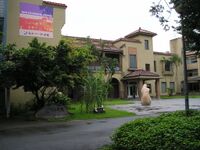
On the evening of February 27, 1947, a Tobacco Monopoly Bureau enforcement team in Taipei went to the district of Taiheichō (太平町), Twatutia (Dadaocheng in Mandarin), where they confiscated contraband cigarettes from a 40-year-old widow named Lin Jiang-mai (林江邁) at the Tianma Tea House. When she demanded their return, one of the men struck her in the head with the butt of his gun,[8] prompting the surrounding Taiwanese crowd to challenge the Tobacco Monopoly agents. As they fled, one agent shot his gun into the crowd, hitting a bystander who died the next day. The crowd, which had already been harboring feelings of frustration from unemployment, inflation, and corruption toward the Nationalist government, reached its breaking point. The crowd protested to both the police and the gendarmes but were mostly ignored.[19]
Protesters gathered the next morning around Taipei, calling for the arrest and trial of the agents involved in the previous day's shooting, and eventually made their way to the Governor General's Office, where security forces tried to disperse the crowd. Soldiers opened fire into the crowd, killing at least three people.[20] The Taiwanese took over the administration of the town and military bases on March 4 and forced their way into local radio station to broadcast news of the incident and calling for people to revolt, causing uprisings to erupt throughout the island.[21][22] By evening, martial law had been declared, and curfews were enforced by the arrest or shooting of anyone who violated curfew.
For several weeks after the February 28 incident, Taiwanese civilians controlled much of Taiwan. The initial riots were spontaneous and sometimes violent, with mainland Chinese receiving beatings from and being killed by Taiwanese. Over 1000 mainlanders were killed.[22][23] Within a few days, the Taiwanese were generally coordinated and organized, and public order in Taiwanese-held areas was upheld by volunteer civilians organized by students, and unemployed former Japanese army soldiers. Local leaders formed Settlement Committees (or Resolution Committees), which presented the government with a list of 32 Demands for reform of the provincial administration. They demanded, among other things, greater autonomy, free elections, the surrender of the ROC Army to the Settlement Committee, and an end to government corruption.[22] Motivations among the various Taiwanese groups varied; some demanded greater autonomy within the ROC, while others wanted UN trusteeship or full independence.[24] The Taiwanese also demanded representation in the forthcoming peace treaty negotiations with Japan, hoping to secure a plebiscite to determine the island's political future.
Outside of Taipei, there were examples of the formation of local militias such as the Communist-inspired 27 Brigade near Taichung. In Chiayi, the mayor's residence was set on fire and local militias fought with the military police.[25]
The Nationalist Government, under governor Chen Yi, stalled for time while it waited for reinforcements from Fujian. Upon their arrival on March 8, the ROC troops launched a crackdown. The New York Times reported, "An American who had just arrived in China from Taihoku said that troops from the mainland China arrived there on March 7 and indulged in three days of indiscriminate killing and arrest. For a time, everyone seen on the streets was fired upon, homes were broken into and occupants arrested. In the lower income sections the streets were said to have been littered with dead.[26]
By the end of March, Chen Yi had ordered the imprisonment or execution of the leading Taiwanese organizers he could identify. His troops reportedly executed, according to a Taiwanese delegation in Nanjing, maybe between 3,000-4,000 people throughout the island, though the exact number is still undetermined.[12] Detailed records kept by the KMT have been reported as missing. Some of the killings were random, while others were systematic. Taiwanese political leaders were among those targeted, and many of the Taiwanese who had formed self-governing groups during the reign of the Japanese were also victims of the February 28 incident. A disproportionate number of the victims had been discharged from the Imperial Japanese Army and came back unemployed were involved in the riots and looting and beating up recent immigrants from China. They presented the most fear as they looked no different from Japanese soldiers from the mainland.[22]
Some political organizations participated in the uprising, for example the Taiwan Democratic Self-Government League, was declared "communist". Many of their members were arrested and executed.[27]
By late March 1947, the central executive committee of the KMT recommended that Chen Yi be dismissed as governor-general over the "merciless brutality" he had shown in suppressing the rebellion.[28] In June 1948, he was appointed provincial chairman of Zhejiang province. In January 1949, he attempted to defect to the Chinese Communist Party, but, Chiang Kai-shek immediately relieved Chen of his duties. Chen Yi was escorted to Taiwan and later imprisoned in Keelung. In May 1950, a Taiwan military court sentenced Chen Yi to death for espionage. On June 18, he was executed at Machangding, Taipei.[29]
الذكرى
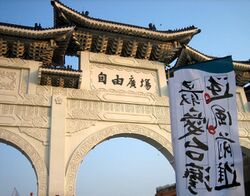

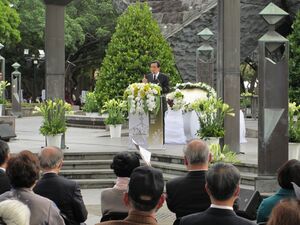

During the February 28 incident, Taiwanese leaders established Resolution Committees in various cities (with a central committee in Taipei) and demanded greater political autonomy. Negotiations with the ROC ended when troops arrived in early March. The subsequent feelings of betrayal felt towards the government and China are widely believed to have catalyzed today's Taiwan independence movement post-democratization.[22] The initial February 28 purge was followed 2 years later by 38 years of martial law, commonly referred to as the "الرعب الأبيض", which lasted until the end of 1987, during which over 100,000 people were imprisoned for political reasons[30] of which over 1,000 were executed.[31] During this time, discussion of the incident was taboo.[32]
In the 1970s, the 228 Justice and Peace Movement was initiated by several citizens' groups to ask for a reversal of this policy,[بحاجة لمصدر] and, in 1992, the Executive Yuan promulgated the "February 28 Incident Research Report".[2] Then-president and KMT-chairman Lee Teng-hui, who had participated in the incident and was arrested as an instigator and a Communist sympathizer, made a formal apology on behalf of the government in 1995 and declared February 28 a day to commemorate the victims.[33] Among other memorials erected, Taipei New Park was renamed 228 Memorial Park.
In 1990, the ROC Executive Yuan set up a task force to investigate the February 28 incident. The "Report of the 228 Incident" (二二八事件研究報告) was published in 1992, and a memorial was set up in 1995 at the 228 Peace Park in Taipei. In October 1995, the state-funded Memorial Foundation of 228 (二二八事件紀念基金會) was established to distribute compensation again and award rehabilitation certificates to February 28 incident victims in order to restore their reputation.[34][35] Family members of dead and missing victims are eligible for NT$6 million (approximately US$190,077).[36] The foundation reviewed 2,885 applications, most of which were accepted. Of these, 686 involved deaths, 181 involved missing persons, and 1,459 involved imprisonment.[37] Many descendants of victims remain unaware that their family members were victims, while many of the families of victims from Mainland China did not know the details of their relatives' mistreatment during the riot. Those who have received compensation two times are still demanding trials of the still-living soldiers and officials who were responsible for the terms of jail and deaths of their loved ones. On the other hand, some survivors thought the arrest and questioning had more to do with looting, riot participation as many unemployed citizens just got discharged from the Japanese Imperial Army from overseas.
On February 28, 2004, thousands of Taiwanese participated in the 228 Hand-in-Hand Rally. They formed a 500-kilometer (310 mi) long human chain from Taiwan's northernmost city to its southern tip to commemorate the incident to call for peace and protest the People's Republic of China's deployment of missiles aimed at Taiwan along the coast of Taiwan Strait.[38]
In 2006, the Research Report on Responsibility for the 228 Massacre (二二八事件責任歸屬研究報告) was released after several years of research. The 2006 report was not intended to overlap with the prior (1992) 228 Massacre Research Report commissioned by the Executive Yuan. Chiang Kai-shek is specifically named as blamed the largest responsibility in the 2006 report.
We think that Chiang Kai-Shek, president of the Nationalist government, should bear the biggest responsibility for the 228 Massacre. Reasons being that he not only was oblivious to warning cautioned by the Control Yuan prior to the Massacre, he was also partial to Chen Yi afterward. None of the provincial military and political officials in Taiwan were punished because of the Massacre. Furthermore, he deployed forces right after the Massacre, as written in a letter by Chen Yi to Chiang Kai-Shek dated March 13: “If not for Your Excellency to mobilize troop rapidly, one could not imagine how far this massacre will lead to.” Chiang Kai-Shek, despite all information he gathered from the party, government, army, intelligence, and representative of Taiwanese groups, still chose to send troops right away; he summoned commander of the 21st division Liu Yu-Cing.[39]
الفن
A number of artists in Taiwan have addressed the subject of the February 28 incident since the taboo was lifted on the subject in the early 1990s.[40] The incident has been the subject of music by Fan-Long Ko and Tyzen Hsiao and a number of literary works.
الأفلام
Hou Hsiao-hsien's A City of Sadness, the first movie that addressed the events, won the Golden Lion at the 1989 Venice Film Festival.[41] The 2009 thriller Formosa Betrayed also relates the incident as part of the motivation behind Taiwan independence activist characters.
الأدب
Jennifer Chow's 2013 novel The 228 Legacy revealed the emotional ramifications for those who lived through the events yet suppressed their knowledge out of fear. It focused on how there was such an impact that it permeated throughout multiple generations within the same family.[42] Shawna Yang Ryan's 2016 novel Green Island tells the story of the incident as it affects three generations of a Taiwanese family,[43] while Julie Wu's novel The Third Son (2013) describes the event and its aftermath from the viewpoint of a Taiwanese boy.[44]
الموسيقى
The Taiwanese metal band Chthonic's album Mirror of Retribution makes several lyrical references to the February 28 incident.
انظر أيضاً
- Formosa Betrayed (1965 book)
- تاريخ تايوان
- تاريخ جمهورية الصين
- قائمة المذابح في تايوان
- قائمة المذابح في الصين
- The First 228 Peace Memorial Monument
- 228 Hand-in-Hand Rally (in 2004)
- الوضع السياسي لتايوان
- الرعب الأبيض (تايوان)
- الإعلان العالمي لحقوق الإنسان (1948)
- انسحاب الكومنتانگ إلى تايوان في 1949
- مظاهرات ميدان تيانآنمن 1989
- احتجاجات هونگ كونگ 2019–2020
ملاحظات
- ^ Interpretations on whether this entails a complete transfer of the territory’s sovereignty to the Republic of China vary. Japan renounced the claims to Taiwan and Pescadores in the معاهدة سان فرانسيسكو in 1952; see Retrocession Day, Theory of the Undetermined Status of Taiwan والوضع السياسي لتايوان.
المراجع
- ^ أ ب Forsythe, Michael (July 14, 2015). "Taiwan Turns Light on 1947 Slaughter by Chiang Kai-shek's Troops". The New York Times. Archived from the original on October 27, 2018.
To somber cello music that evokes 'Schindler's List,' displays memorialize the lives lost, including much of the island's elite: painters, lawyers, professors, and doctors. In 1992, an official commission estimated that 18,000 to 28,000 people had been killed.
- ^ أ ب ت Kristof, Nicholas D. (April 3, 1992). "Taipei Journal – The Horror of 2-28: Taiwan Rips Open the Past". The New York Times. Archived from the original on December 13, 2018. Retrieved March 1, 2020.
- ^ Wu, Naiteh (July 2005). "Transition without Justice, or Justice without History: Transitional Justice in Taiwan" (PDF). Taiwan Journal of Democracy (1): 10. Archived from the original (PDF) on February 25, 2021.
The memory of the February 28 massacre, although politically taboo during the KMT's authoritarian rule
- ^ "Taiwan's hidden massacre. A new generation is breaking the silence". The Washington Post. March 1, 2017.
realization that his grandfather had been one of the tens of thousands of victims targeted and murdered in Taiwan's 'February 28 Massacres.'
- ^ أ ب Shattuck, Thomas J. (February 27, 2017). "Taiwan's White Terror: Remembering the 228 Incident". Foreign Policy Research Institute.
In Taiwan, the period immediately following the 228 Incident is known as the 'White Terror' ... . Just blocks away from the Presidential Palace in Taipei is a museum and park memorializing the victims of the 228 Massacre
- ^ "China's other massacre". June 4, 2019.
- ^ Fleischauer, Stefan (November 1, 2007). "The 228 Incident and the Taiwan Independence Movement's Construction of a Taiwanese Identity". China Information. 21 (3): 373–401. doi:10.1177/0920203X07083320. S2CID 143766317.
- ^ أ ب ت Chou, Wan-yao (2015). A New Illustrated History of Taiwan. Translated by Plackitt, Carole; Casey, Tim. Taipei: SMC Publishing Inc. p. 317. ISBN 978-957-638-784-5.
- ^ Ko, Shu-ling; Chang, Rich; Chao, Vincent Y. (March 1, 2011). "National 228 museum opens in Taipei". Taipei Times. p. 1. Retrieved November 14, 2014.
- ^ Chen, Ketty W. (February 28, 2013). "Remembering Taiwan's Tragic Past". Taipei Times. p. 12. Retrieved November 14, 2014.
- ^ Lin, Sean (October 6, 2018). "Commission exonerates 1,270 people". Taipei Times. Taipei. Retrieved August 22, 2019.
- ^ أ ب "DPP questions former Premier Hau's 228 victim figures". The China Post. Taipei. February 29, 2012. Archived from the original on 29 November 2019. Retrieved November 14, 2014.
{{cite news}}:|archive-date=/|archive-url=timestamp mismatch; 29 نوفمبر 2014 suggested (help) - ^ Wu, J.R. (October 25, 2015). "Taiwan president says should remember good things Japan did". Reuters. Retrieved March 11, 2020.
Unlike in China or Korea, many Taiwanese have a broadly more positive view of Japan than people in China or Korea, saying that Japan's rule brought progress to an undeveloped, largely agricultural island.
- ^ Abramson, Gunnar (2004). "Comparative Colonialisms: Variations in Japanese Colonial Policy in Taiwan and Korea, 1895 ‐ 1945". PSU McNair Scholars Online Journal. 1 (1): 11–37. doi:10.15760/mcnair.2005.11.
- ^ Cui Meiming (March 1, 1998). "大「劫收」与上海民营工业" ["Dajieshou yu Shanghai minying gongye," ["The catastrophic "taking-over" and Shanghai's private-owned industries"]. Dang 'an Yu Shixue. 檔案與史學 (3): 43−55.
- ^ "Formosa After the War". Reflection on the 228 Event—The first gunshot. 2003. Archived from the original on March 6, 2006. Retrieved March 6, 2006.
- ^ "Foreign News: This Is the Shame". Time. June 10, 1946.
- ^ Cai, Xi-bin (January 11, 2010). The Taiwan province working committee organization of the CCP (1946~1950) in Taipei city (Thesis). National Tamkang University.
- ^ (in zh)民報社 (Taiwan Ministry of Culture:National Repository of Cultural Heritage), February 28, 1947, http://nrch.cca.gov.tw/ccahome/search/search_meta.jsp?xml_id=0001716464&dofile=getImage.jsp?d=1241951145639&id=0001648015&filename=cca100003-np-mingpo19470228-03-i.jpg
- ^ "Seizing cigarettes incident". Reflection on the 228 Event—The first gunshot. 2003. Archived from the original on March 6, 2006. Retrieved March 6, 2006.
- ^ Durdin, Peggy (May 24, 1947). "Terror in Taiwan". The Nation. Archived from the original on April 24, 2006. Retrieved April 22, 2006.
- ^ أ ب ت ث ج Smith, Craig A (2008). "Taiwan's 228 Incident and the Politics of Placing Blame". Past Imperfect. University of Alberta. 14: 143–163. ISSN 1711-053X. Retrieved November 13, 2014.
- ^ Zhu Tianwen 朱天文, Bei qing cheng shi 悲情城市 [A City of Sadness], DVD, directed by Hou Hsiao-hsien侯孝賢 (Taiwan: 3-H Films/Era, 1989)
- ^ Durdin, Tillman (March 30, 1947). "Formosans' Plea For Red Aid Seen". The New York Times. Archived from the original on February 15, 2006. Retrieved March 6, 2006.
- ^ Yang, Bi-chuan (February 25, 2017). "The 228 Massacre in Chiayi: "The Airport and Train Station Were Washed with Blood". The Reporter (報導者). Retrieved August 19, 2018.
- ^ Durdin, Tillman (March 29, 1947). "Formosa killings are put at 10s 1000s". The New York Times. Archived from the original on April 24, 2006. Retrieved April 22, 2006.
- ^ Wang, Xiaobo (February 2004). Taiwan Democratic Self-Government League and the February 28 Incident. Taipei: Straits Academic Press.[صفحة مطلوبة]
- ^ "Chiang to Formosa?". Argus-Press. Owosso, Michigan. January 14, 1949. Retrieved April 8, 2019.
- ^ "Formosa Chief Executed As Traitor". Schenectady Gazette. AP. June 18, 1950. Retrieved November 13, 2014.
- ^ Bird, Thomas (August 1, 2019). "Taiwan's brutal White Terror period revisited on Green Island: Confronting demons inside a former prison". South China Morning Post. Retrieved March 1, 2020.
- ^ Mozur, Paul (February 3, 2016). "Taiwan Families Receive Goodbye Letters Decades After Executions". The New York Times. Retrieved March 1, 2020.
- ^ Horton, Chris (February 26, 2017). "Taiwan Commemorates a Violent Nationalist Episode, 70 Years Later". The New York Times. Retrieved March 2, 2020.
- ^ Mo, Yan-chih (February 28, 2006). "Remembering 228: Ghosts of the past are yet to be laid to rest". Taipei Times. p. 4. Archived from the original on July 15, 2019. Retrieved November 14, 2014.
- ^ Lee Hsin-fang (29 May 2017). "Extension requested for 228 claimants". Taipei Times. Archived from the original on 25 February 2021. Retrieved 17 October 2022.
- ^ "Operation". Memorial Foundation of 228. 2018. Archived from the original on July 31, 2019.
- ^ "Japanese 228 victim's son awarded compensation". Taipei Times. February 18, 2016.
- ^ "賠償金申請相關事宜|財團法人二二八事件紀念基金會.二二八國家紀念館".
- ^ Chang, Yun-ping (2004-02-29). "Two million rally for peace". Taipei Times. Retrieved 2022-02-26.
- ^ Chen, Yi-shen (February 2005). "Research Report on Responsibility for the 228 Massacre, Chapter II: Responsibility on the part of the decision-makers in Nanjing". 228.org.tw. The 228 Memorial Foundation. Archived from the original on February 28, 2015. Retrieved November 14, 2014.
- ^ "228 Massacre, 60th Commemoration". Retrieved March 12, 2017.
- ^ "A City of Sadness". October 21, 1989. Retrieved March 12, 2017 – via IMDb.
- ^ Bloom, Dan (August 19, 2013). "US author probes 'legacy' of the 228 Incident in novel". Taipei Times. p. 3. Retrieved May 7, 2014.
- ^ Publishers' information:
- "Green Island by Shawna Yang Ryan - PenguinRandomHouse.com". Retrieved March 12, 2017.
- "Green Island by Shawna Yang Ryan". www.penguin.com.au (in الإنجليزية).
- Ryan, Shawna Yang (2016). Green Island (First ed.). New York: Knopf. ISBN 9781101872369.
- ^ Wu, Julie (2013). The third son: a novel (1st ed.). Chapel Hill, North Carolina: Algonquin Books of Chapel Hill; Workman Publishing. ISBN 9781616203276. [Publisher's notes]
ببليوگرافيا
- Kerr, George H.; Stuart, John Leighton (April 21, 1947). 'Memorandum on the Situation in Taiwan'. American Embassy, Nanking, China. Telegram No. 689.. Reprinted in: Acheson, Dean (August 1949). United States relations with China, with special reference to the period 1944–1949, based on the files of the Department of State. Far Eastern Series. Compiled from Department of State records. Washington: U.S. Govt. Print. Off. pp. 923–938. hdl:2027/umn.31951d01115459w. OCLC 664471448.
- Kerr, George H. (1965). Formosa Betrayed. Boston: Houghton Mifflin. OL 5948105M.
- Lai, Tse-han; Myers, Ramon Hawley; Wei, Wou (1991). A Tragic Beginning: The Taiwan Uprising of February 28, 1947. Palo Alto: Stanford University Press. ISBN 9780804718295.
- Shackleton, Allan J. (1998) [1948]. Formosa Calling: An Eyewitness Account of Conditions in Taiwan during the February 28th, 1947 Incident. Upland, California: Taiwan Publishing Company. OCLC 419279752. Retrieved November 20, 2014.
- Wakabayashi, Masahiro (2003). "4: Overcoming the Difficult Past; Rectification of the 2–28 Incident and the Politics of Reconciliation in Taiwan". In Funabashi, Yōichi (ed.). Reconciliation in the Asia-Pacific. Washington, D.C.: United States Institute of Peace Press. pp. 91–109. ISBN 9781929223473. OCLC 51755853.
وصلات خارجية
| مراجع مكتبية عن حادثة 28 فبراير |
- "Taipei 228 Memorial Museum (臺北228紀念館)". culture.tw. Taiwan Ministry of Culture. Archived from the original on November 29, 2014. Retrieved November 14, 2014.
- Hong, Keelung. "My Search for 2–28" Berkeley, California (February 28, 2003).
- "The 228 Massacre, As Documented in the US Media". 2001. Archived from the original on June 7, 2007. Retrieved November 20, 2014.
- "Reflection on the 228 Event". Taiwan Human Rights InfoNet. 2003. Archived from the original on September 27, 2007. Retrieved November 20, 2014.
- 財團法人二二八事件紀念基金會 [228 Incident Memorial Foundation] (in الصينية). 2011. Retrieved November 20, 2014.
- Chu, Bevin (February 25, 2000). "Taiwan Independence and the 2–28 Incident". The Strait Scoop. Retrieved November 20, 2014.
- "Taiwan Yearbook 2006: The ROC on Taiwan — February 28 Incident". Taiwan Government Information Office. Archived from the original on August 1, 2007. Retrieved November 20, 2014.
- "Declaration of Formosan Civil Government 福爾摩沙平民政府宣言". 2009. Retrieved November 20, 2014.
- 〈社論〉二二八不是內部鎮壓而是國際罪行 [Editorial: 228 was not internal repression, but an international war crime instead]. Liberty Times (in الصينية). Taipei. February 28, 2007. Archived from the original on July 30, 2013. Retrieved November 20, 2014.
- "Editorial: Historical record is key to justice". Taipei Times. February 28, 2007. p. 8. Retrieved November 20, 2014.
- The 228 Incident and Taiwan's Transitional Justice – The Diplomat
- Japanese 228 victim's son awarded compensation – Taipei Times
- Tsai vows to investigate 228 Incident – Taipei Times
- Family of Korean killed in Taiwan's '228 Incident' in 1947 to get compensation – The Japan Times
- KMT slows transitional justice: Koo – Taipei Times
- Forum underlines importance of 228 education – Taipei Times
- Chiang Kai-shek removal backed – Taipei Times
- 228 evidence indicts Chiang: academic – Taipei Times
- Document unearthed shows double-dealing of Chiang behind 228 Incident – تايوان نيوز
- CS1 errors: archive-url
- مقالات بالمعرفة بحاجة لذكر رقم الصفحة بالمصدر from February 2022
- Short description is different from Wikidata
- Missing redirects
- Articles with hatnote templates targeting a nonexistent page
- Articles containing صينية-language text
- Articles containing traditional Chinese-language text
- Articles with unsourced statements from February 2022
- CS1 uses الصينية-language script (zh)
- CS1 الصينية-language sources (zh)
- حادثة 28 فبراير
- 1947 في تايوان
- احتجاجات 1947
- نزاعات 1947
- كومنتانگ
- تمردات الحرب الباردة
- أحداث فبراير 1947 في آسيا
- قتل جماعي في 1947
- احتجاجات في تايوان
- Protest-related deaths
- تمردات في آسيا
- حركات الديمقراطية التايوانية
- حركة استقلال تايوان
- الرعب الأبيض (تايوان)
- عقد 1940 في تايوان
- تمردات القرن العشرين

